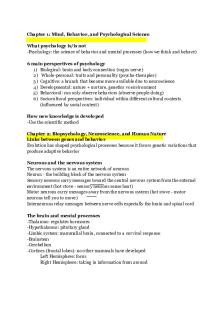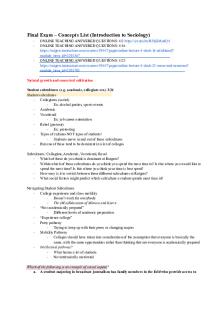Study Guide Intro to pub Speak PDF

| Title | Study Guide Intro to pub Speak |
|---|---|
| Author | Hanah Ramsey |
| Course | Intro to Public Speaking |
| Institution | University of Akron |
| Pages | 8 |
| File Size | 117.6 KB |
| File Type | |
| Total Downloads | 13 |
| Total Views | 198 |
Summary
Study guide for Introduction to Public Speaking Exam 1...
Description
Exam #1 Study Guide Introduction to Public Speaking Chapters 1,2,3,5,6,7,8,9,11,13
Chapter 1 Study Questions
➔ Explain the importance of civic engagement as it relates to public speaking Actively participating in community or public affairs,not only by voting, but keeping up with the news, discussing issues. Advocating for a certain cause or joining a movement relates to public speaking. ➔ How can we be engaged citizens? Getting involved. Speaking out at town hall forum, volunteering to help others. Communicate with others and communicate responsibly. ➔ How has the rhetorical tradition shaped how we view public speaking? Public speaking must be grounded in a strong code of ethics and a commitment to the public good. Good character of the speaker. Shared interest of the listeners. ➔ What is civic literacy? The historical, political, and cultural knowledge necessary to participate actively as a citizen in a democracy ➔ Explain what plagiarism is and how we can avoid it Taking all or part of a speech from a source without proper attribution. Paraphrasing. Paraphrasing refers to putting the ideas or insights of others into your own words. Language that differs significantly from the original. When in doubt, cite your sources. ➔ How can we deliberate in good faith? Discussing controversial issues in a spirit of mutual respect, with a commitment to telling the truth, backing up arguments with reasoning and evidence, and remaining open to changing one’s mind. Well informed and fully prepared. ➔ What is demagoguery? Deceptive or manipulative speech, often relying upon the charismatic ethos of the demagogue and appealing to dark emotions like fear. Hitler is an example.
Chapter 2 Questions
➔ What are the elements of the Transactional Model of Communication? Why is it transactional? Encode; take your ideas and put them in a speech. Decode; listeners interpret your message. Noise; any interference that distorts message flow within the speech. Process of constructing shared messages or understandings. ➔ What is the difference between listening for enjoyment and critical listening? Listening to show your support and understanding for the feelings of another person. You aim to analyze and evaluate a speaker’s message. ➔ Why should we avoid the Passivity Syndrome? Fails to acknowledge the transactional nature of communication; the fact that effective communication requires the active participation of both speakers and listeners. ➔ What is stereotyping? How can it interfere with our ability to communicate? Making assumptions about someone based on factors such as race or gender without considering the person’s individuality. When we focus on a speaker’s gender we are focusing on things that have little or nothing to do with his or her message. ➔ How can we prepare to listen? Be informed. Recognize your own opinions; Commit to an open mind. Identify your goals; Listening purposefully. Understanding the circumstances; setting of a speech. Understand the target audiences. Consider the speaker’s purpose; what the speaker hopes to accomplish. ➔ What is active listening? Concentrating on the speaker’s message. Take notes as you listen. Analyze the quality of the speaker’s ideas. Be aware of the speaker’s credibility. ➔ Explain ethos. Ethical proof or the audience’s perception of the speaker’s credibility. ➔ What should we “know” when we prepare to speak? Know yourself; study, research and a desire to speak. Know your audience; consider your audience’s needs, interests. Know the situation; setting of the speech.
Chapter 3 Questions ➔ Explain Communication apprehension. Feelings of anxiety a speaker may experience before or during a public presentation. ➔ What is the difference between trait and state anxiety? Apprehensive when called upon to speak. A particular set of circumstances triggers their communication apprehension. ➔ What are ways we can manage speech anxiety? A genuine commitment to your topic can help you overcome the anxiety. Extra time to research. Being well prepared. Developing positive thoughts. Practice your speech. Chapter 5 Questions ➔ What ethical considerations are there in selecting topics for public speaking? Clearly wrong to make up information or to distort quoted material. Repeating as “true” some rumor for which there is no proof is also unethical. Accuracy; do your research. To remain open to competing ideas. Avoid controversial issues. ➔ Be able to recognize and tell the difference between a general purpose, specific purpose and thesis statement. General Purpose; ultimate goal in speaking, audience understanding. Specific Purpose; the response the speaker hopes to achieve. Thesis Statement; declarative statement that sums up the central idea of your speech.
Chapter 6 Questions ➔ What is information literacy? Understanding when information is needed and knowing how to locate, gather, and evaluate information and use it responsibly.
➔ How can we evaluate information we use in our speeches? Currency; date of publication. Authority; author’s expertise. Validity; cited sources. Audience; appropriate for audience. Point of View; is the information one sided. ➔ How can we evaluate sources we find on the internet? Source of Information. Purpose of the page. How accurate the information is. How current is the site. When was the site created. ➔ What is the correct way to verbally cite sources during speeches? You may quote the source or paraphrase. You will need to reveal the source during your presentation. Provide enough information to convince the audience of the credibility of the source. Need the full citation. Chapter 7 Questions ➔ Explain the best way to use facts and definitions in speeches. Evaluate how facts are labeled or described. Validate them by consulting multiple, credible sources. You should define any acronyms that may be unfamiliar. Can be straightforward or challenge the audience. ➔ What are the different types of examples that can be used in public speeches? Actual examples; real life cases or specific instances. Hypothetical examples; events that did not actually happen but that might or could occur. Narrative examples; example that tells a story, based on true experiences or symbolism. ➔ What is the difference between statistical descriptions and inferential statistics? Numerical method of interpreting large numbers of instances to display trends. Generalizes from a small group or sample to some larger population. ➔ What is a good rule to remember when using statistics in speeches? Statistics by themselves don’t prove anything. Statistics should only be used when they provide needed support. Present the statistics clearly and meaningfully. ➔ How can we evaluate support material we find? Accuracy. Completeness. Recency. Source Reliability. Audience Appropriateness. Ethical Considerations.
Chapter 8 Questions ➔ Define internal preview, internal summary, and signposts. Why are these important to include in your speech? A quick look ahead at what will be covered under one of the main points. Brief review of what one has presented under a main point. Words that alert listeners to where you are in your speech. Keeps the audience mentally on track. Setting the stage for a particular portion of your speech. Alert the audience you are moving from one idea to another. ➔ What elements should be included in an introduction and conclusion of speeches? Maintain the listener’s attention. Significance of your topic. Advance your thesis. Preview your main points. Summarize your ideas. Appeal to your audience. Refer to the introduction. Chapter 9 Questions ➔ What are the differences between a formal and key word outline? When should a speaker use either? An outline in which ideas and their development are articulated completely and precisely. An abbreviated outline that serves as a speaker’s notes during the delivery. Formal outlines contain fully developed ideas. The keyword outline is speaking notes. Chapter 11 Questions ➔ Define pitch, rate, volume and clarity. Pitch; highness or lowness of the voice on a musical scale. Rate; how fast or slow you deliver your speech. Volume; volume should be determined by the setting in which you speak. Clarity; Articulation. ➔ Why is speaking extemporaneous beneficial? Keeps you on track and reminds you of your main ideas. You can speak more directly with your audience. Flexibility to adapt to changing circumstances. ➔ What are the pros and cons of manuscript reading, impromptu and memorized speaking? Manuscript reading demands a special focus on using good oral style,
incorporating gestures. The manuscript allows you to say precisely what you planned to say. Impromptu reading requires some preparation and organization. Impromptu reading is on the cuff and casual. Memorized speaking requires extensive practice. Memorized speaking is a speech presented from memory. Chapter 13 Questions ➔ How can listeners and speakers both benefit from the effective usage of presentational aids? Promoting Clarity; human brains learn from audio visuals. Assisting Retention; information is more understandable and memorable. Providing Emphasis; underscore what is most important. Providing Support; function as evidence to support ideas. ➔ What are the guidelines for preparing presentational aids? Employ an actual aid; adds clarity, encourages interest. Design your ad for quick processing; grasp the meaning with minimal effort. Strive for professional quality. Employ silence; avoid using too many visual aids. Anticipate Problems. ➔ What are the guidelines for using presentational aids? Practice. Preview in the venue; check out the actual setting. Have everything set to go. Use visual aids only when needed. Help listeners focus. Stay connected with your listeners. Use presentational aids ethically....
Similar Free PDFs

Study Guide Intro to pub Speak
- 8 Pages

Intro to Biology Exam 2 study guide
- 11 Pages

Intro to sociology ch 1 study guide
- 11 Pages

Intro to Stats Final Study Guide
- 15 Pages

Intro study Guide 1
- 15 Pages

Microscope Intro Study Guide
- 2 Pages
Popular Institutions
- Tinajero National High School - Annex
- Politeknik Caltex Riau
- Yokohama City University
- SGT University
- University of Al-Qadisiyah
- Divine Word College of Vigan
- Techniek College Rotterdam
- Universidade de Santiago
- Universiti Teknologi MARA Cawangan Johor Kampus Pasir Gudang
- Poltekkes Kemenkes Yogyakarta
- Baguio City National High School
- Colegio san marcos
- preparatoria uno
- Centro de Bachillerato Tecnológico Industrial y de Servicios No. 107
- Dalian Maritime University
- Quang Trung Secondary School
- Colegio Tecnológico en Informática
- Corporación Regional de Educación Superior
- Grupo CEDVA
- Dar Al Uloom University
- Centro de Estudios Preuniversitarios de la Universidad Nacional de Ingeniería
- 上智大学
- Aakash International School, Nuna Majara
- San Felipe Neri Catholic School
- Kang Chiao International School - New Taipei City
- Misamis Occidental National High School
- Institución Educativa Escuela Normal Juan Ladrilleros
- Kolehiyo ng Pantukan
- Batanes State College
- Instituto Continental
- Sekolah Menengah Kejuruan Kesehatan Kaltara (Tarakan)
- Colegio de La Inmaculada Concepcion - Cebu









